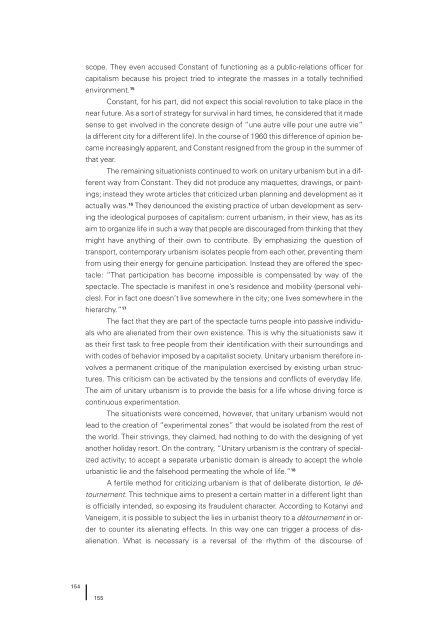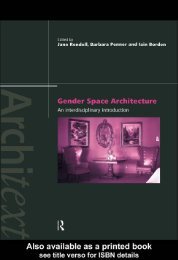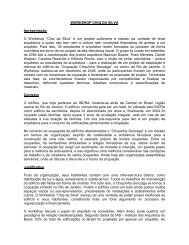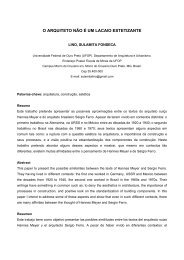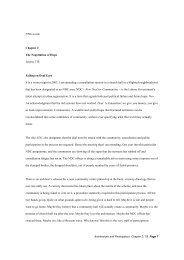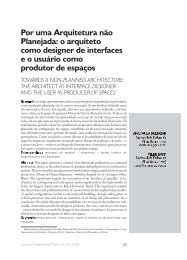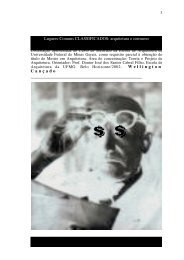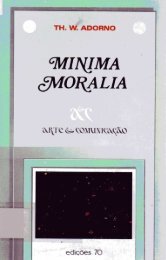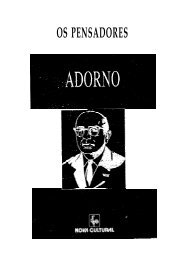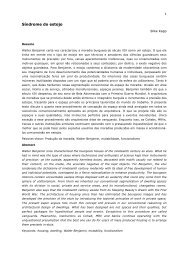Architecture and Modernity : A Critique
Architecture and Modernity : A Critique
Architecture and Modernity : A Critique
Create successful ePaper yourself
Turn your PDF publications into a flip-book with our unique Google optimized e-Paper software.
154<br />
scope. They even accused Constant of functioning as a public-relations officer for<br />
capitalism because his project tried to integrate the masses in a totally technified<br />
environment. 15<br />
Constant, for his part, did not expect this social revolution to take place in the<br />
near future. As a sort of strategy for survival in hard times, he considered that it made<br />
sense to get involved in the concrete design of “une autre ville pour une autre vie”<br />
(a different city for a different life). In the course of 1960 this difference of opinion became<br />
increasingly apparent, <strong>and</strong> Constant resigned from the group in the summer of<br />
that year.<br />
The remaining situationists continued to work on unitary urbanism but in a different<br />
way from Constant. They did not produce any maquettes, drawings, or paintings;<br />
instead they wrote articles that criticized urban planning <strong>and</strong> development as it<br />
actually was. 16 They denounced the existing practice of urban development as serving<br />
the ideological purposes of capitalism: current urbanism, in their view, has as its<br />
aim to organize life in such a way that people are discouraged from thinking that they<br />
might have anything of their own to contribute. By emphasizing the question of<br />
transport, contemporary urbanism isolates people from each other, preventing them<br />
from using their energy for genuine participation. Instead they are offered the spectacle:<br />
“That participation has become impossible is compensated by way of the<br />
spectacle. The spectacle is manifest in one’s residence <strong>and</strong> mobility (personal vehicles).<br />
For in fact one doesn’t live somewhere in the city; one lives somewhere in the<br />
hierarchy.” 17<br />
The fact that they are part of the spectacle turns people into passive individuals<br />
who are alienated from their own existence. This is why the situationists saw it<br />
as their first task to free people from their identification with their surroundings <strong>and</strong><br />
with codes of behavior imposed by a capitalist society. Unitary urbanism therefore involves<br />
a permanent critique of the manipulation exercised by existing urban structures.<br />
This criticism can be activated by the tensions <strong>and</strong> conflicts of everyday life.<br />
The aim of unitary urbanism is to provide the basis for a life whose driving force is<br />
continuous experimentation.<br />
The situationists were concerned, however, that unitary urbanism would not<br />
lead to the creation of “experimental zones” that would be isolated from the rest of<br />
the world. Their strivings, they claimed, had nothing to do with the designing of yet<br />
another holiday resort. On the contrary, “Unitary urbanism is the contrary of specialized<br />
activity; to accept a separate urbanistic domain is already to accept the whole<br />
urbanistic lie <strong>and</strong> the falsehood permeating the whole of life.” 18<br />
A fertile method for criticizing urbanism is that of deliberate distortion, le détournement.<br />
This technique aims to present a certain matter in a different light than<br />
is officially intended, so exposing its fraudulent character. According to Kotanyi <strong>and</strong><br />
Vaneigem, it is possible to subject the lies in urbanist theory to a détournement in order<br />
to counter its alienating effects. In this way one can trigger a process of disalienation.<br />
What is necessary is a reversal of the rhythm of the discourse of<br />
155


